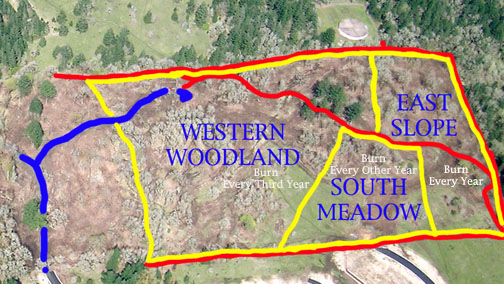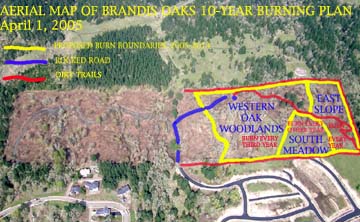Goal 8.
Reintroduction of Indian-type Burning

This April 1, 2005 map shows three
principal areas proposed for 10-year burning study.
This goal proposes that Indian-type burning
methods should be used on a mid-term experimental basis (training and research)
for
purposes of sustained maintenance of
oak
savannah
habitat and
for addressing goals 1, 2, 4, 6, and 7.
At this time very little is known about maintenance
of stable native oak savannah conditions in the Willamette Valley, in part because few such conditions remain.
In
the past, Kalapuyan people maintained
savannah conditions with regular burning strategies, but that was more
than 150
years ago and the region's wild plant and animal populations have been
forever
changed since then. The introduction of thousands of new species of plants and
animals in the last 150 years
It is very likely that regular burning can still
be an
effective tool in maintaining oak savannah conditions over long periods
of
time, particularly at a landscape-scale of thousands of acres. It is also possible that regular burning can
maintain similar conditions in stand-scale increments as small as five
or ten
acres; one of the more important management questions asked by this
project. Invasive weeds are another
modern problem. Regular burning may
favor many of them and help them to spread.
It is hoped that a steady program of spot spraying with
herbicides will
help resolve the weed problem (see Goal 6), and that regular burning
will also
be helpful--at least for some species, such as poisonoak.
This experiment tests the responses of target and
focus
plant and animal species, including weeds and pests, to the
reintroduction of
regular burning practices that have been absent from the environment
for more
than 150 years. The oak savannah
environment is divided into three meadows of varying aspect--south,
east, and
west--and each is burned at one-, two-, and three-year intervals for a
nine-year period. We know Kalapuyan
people, including local Chepenafa, burned larges areas on an annual
basis at a
time that was good for roasting tarweed seeds on their stalks; usually
between
late August and early October by most historical accounts.
Other areas were burned less often,
particularly areas in which woody shrubs were grown.
Burns are timed to reflect Indian burning
schedules (toasting ripe tarweed seeds is a major factor for prairies,
but oak
woodlands might burn better in fall or winter), and are intended to
directly
involve the public. Relict and
introduced plant populations will be mapped over that time period to
chart
their responses to the differing burn schedules.
The maintenance of oak savannah habitat conditions
and the
control of modern weeds in native environments are important problems. Smoke management and wildfire control (see
Goal 7) are other important considerations related to the
reintroduction of
fire into the environment. Potential
negative reactions from local residents can hopefully be mitigated by
the
opportunity to have local Corvallis City Fire Department firefighters
conduct
training exercises with the scheduled brush pile and meadow burns, and
to work
directly with local schools and tribes in implementing this experiment.

10-Year Burn Schedule
Year 1 2005 Burn south meadow, including
repaired area
(late summer).
Year 2 2006 Burn piles and draws
(winter); east slope (late summer).
Start Experiments
(student-designed native plant and weed response studies)
Year 3 2007 Burn south meadow, east slope, and
west
woodlands.
Year 4 2008 Burn east slope.
Year 5 2009 Burn south meadow and east slope.
Year 6 2010 Burn east slope and west woodlands.
Year 7 2011 Burn south meadow and east slope.
Year 8 2012 Burn east slope.
Year 9 2013 Burn south meadow, east slope, and
west
woodlands.
Analysis
Year 10
2014 No
burns: assess resulting trends and conditions and make new plans.
Summary: Proposed 2005 - 2014 Burning Schedule
1)
Maintained & repaired
south meadow: burned 5 times at two-year intervals.
2)
Established new east
prairie: burned 8 consecutive years.
3) Extended
existing west meadow and restored
woodlands: burned 3 times at three-year intervals.
Predictions
We assume that Kincaid's lupine and other favored
savannah
plants will respond in a positive way to historical management
patterns; some
plants will respond more favorably to different aspects or burn
schedules than
others. Because Brachypodium it is an
exotic species and has never been subjected to regular burning locally,
we
don't know how it will respond over time.
In addition to providing valuable training and
research
opportunities, the information gained by this experiment will be
extremely
useful in guiding the long-term management strategies need to maintain
oak
savannah conditions over time.

© 2005 by Oregon
Websites and Watersheds Project, Inc.

